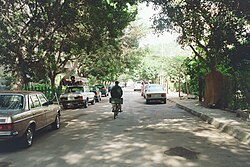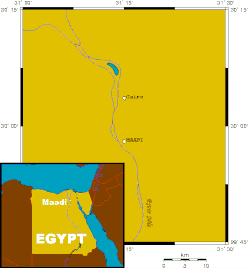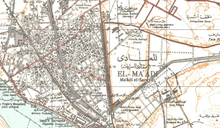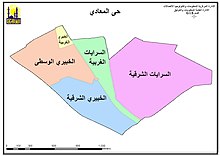Maadi
Maadi
المعادى | |
|---|---|
District 12 | |
| Arabictranscription(s) | |
| • Common | Al-Ma‛adi |
 | |
 Map of Maadi (inset: map of Egypt) | |
| Coordinates:29°58′3″N31°15′0″E/ 29.96750°N 31.25000°E | |
| Country | Egypt |
| Governorate | Cairo |
| Population (2023) | |
| • Total | 95,190 |
| Time zone | UTC+2(Egypt Standard Time) |
Maadi(Egyptian Arabic:المعادىel-Maʿādi[elmæˈʕæːdi]) is a leafy and once suburban district in the Southern Area ofCairo,Egypt,[1]on the east bank of theNileabout 12 kilometers (7.5 mi) upriver from downtown Cairo. The modern extensions north east and east of Maadi, New Maadi and Zahraa al-Maadi are administratively part of the Basatin district.[1]
TheNileat Maadi is paralleled by theCorniche,a waterfront promenade and the main road north into Cairo. There is no bridge across the Nile at Maadi; the nearest one is located at El Mounib along the Ring Road (Tarik El-Da'eri, English:The Round Road) on the way north to the downtown.
Maadi's population was estimated to be 85,000 according to the 2017 census.[2]The district is popular with international expatriates as well as Egyptians and is home to many embassies, as well as major international schools, sporting clubs, and cultural institutions such as theSupreme Constitutional Court of Egyptand the nationalEgyptian Geological Museum.
Name[edit]
Maadiis the plural form of the wordmeʿaddeyya(معدية[meʕædˈdej.jæ]), which means "ferry"; hence, el-Maadi literally means "The ferries". The story goes that the name comes from a ferry crossing in the area where ferries carried people from the east side of theNileto the west.
History[edit]
Maadi today stands on the site of a town that has turned out to be a significantpredynastic,Ancient Egyptian archaeological site, founded ca. 3500 B.C.[3]Building activity in the area has destroyed some archaeologically sensitive places.[4]
InMiddle Agesthe area of Maadi became aCopticmonasticregion comprisingDeir at-Tin(Arabic:دير الطين,Coptic:ⲡⲓⲙⲟⲛⲁⲥⲧⲉⲣⲓⲟⲛ ⲙ̀ⲡⲓⲟⲙⲓ,lit. 'monastery of mud')[5]andDeir al-Adawiya(Arabic:دير العدوية,Coptic:ϯⲕⲁⲗⲁⲃⲏ).[6]
Maadi traces its modern history to 1904, when therailwaybetween Cairo to the north andHelwanto the south was built. This, in combination with land speculation by the Mosseri cousins and city planning by Alexander Adams, gave rise to a new town. Construction was originally limited to the area adjacent to the railway, but eventually spread west to theNile.Also, a large British army camp was built east of the railway.
Thetown planningwas done in 1905 by aCanadianretired officer, Captain Alexander J. Adams. His vision led to the wide streets and large villas still seen in Maadi today. There were very strict rules associated with residential development in Maadi with regards to the size of houses, how much of the property could be occupied by the house and how much had to be left for the garden, and the size of thesidewalks.Even window shutters had prescribed colours. Other regulations included wireless radio noise control after 22:00 and fines for not maintaining gardens properly.[7]

The world's first solar thermal power station was built in Maadi.[8]

An example ofBritish coloniallife in Maadi may be found inThe house at Maadi,ashort storybyGerald Bullettfrom his collectionThe street of the eye(1923).[9]
Second World War[edit]
During the period between 1940 and 1945, Maadi had an important role in theMilitary of New Zealand during World War II. TheDivisional Cavalry Regimentdisembarked on 14 February 1940 and entrained for the New Zealand base camp at Maadi.[10]In total around 76,000 members of the2nd New Zealand Expeditionary Forcetrained at a camp near Maadi at the base of the desert slopes of Wadi Degla and Tel al-Maadi. During that time this area belonged to the Delta Land Company which created Maadi in 1907. The rocky plateau was leased to theNew Zealand Military Forces,and for the next six years it became the central depot and training area for 2 NZEF in the Middle East.[10]
ABritish Armyinterrogation centre was also located in Maadi. In July 1942, at the height of theWestern Desert Campaign,twoGermanspies revealed under questioning that they had been using a copy ofDaphne du Maurier'sRebecca,found among their possessions, as acodebookfor secret, coded radio transmissions. Their equipment, stored on ahouseboaton the River Nile, had been examined by a young signals officer from theEgyptian Army,futurePresident of EgyptAnwar Sadat.[7]
Post-1952 revolution[edit]
Following the1952 revolution(which ended the British occupation of theSuez Canal) and the 1956Suez Crisis,in which Britain, France and Israel launched an invasion of Egypt to regain control of the canal, British and French expatriates living in Maadi and elsewhere were forced to leave by the Egyptian government. As a result, some of their institutions, such as St John's Anglican Church, were taken over and run temporarily by other nationalities.[citation needed]
Administrative divisions and population[edit]
Maadi is a district in the Southern Area of Cairo,[1]and is subdivided into five shiakhas (census blocks).

In the 2017 census Maadi had a total population of 108,575 people spread over the five shiakhas as follows:[2]
| Shiakha | Code 2017 | Population |
|---|---|---|
| Ma`âdî al-Sarâyât al-sharqiyya | 010604 | 25,177 |
| Ma`âdî al-Sarâyât al-gharbiyya | 010605 | 26,501 |
| Ma`âdî al-Khabîrî al-wusṭä | 010603 | 26,897 |
| Ma`âdî al-Khabîrî al-sharqiyya | 010601 | 7393 |
| Ma`âdî al-Khabîrî al-gharbiyya | 010602 | 2607 |
Maadi today[edit]

The oldest area in Maadi is El Sarayat, composed mostly of villas and low rise buildings. It is the most affluent part of Maadi along with the adjacent Degla area. These two areas are recognizable by the high number of roundabouts, quiet atmosphere and greenery.
There are manyflatsin Maadi, mostly inlowrisebuildings. There are severalhighrisesalong theCornicheby the river, as well as in the newer, eastern part of Maadi, known as Degla.
The new Maadi areas include El-Laselky St. and the Autostrad, as well as Masaken El Arays, Saqr kuraish and the houses of the Kuwaiti company, and el basatin el sharkya. which is between saqr kuraish and the houses of the Kuwait company. It is characterized by the large number of oil companies, most notably the Gulf of Suez Oil Company, as well as some other companies. The Arab region is also the most popular areas in Maadi and the Arab Maadi which is available from shops and crafts and various means of transport and its location, which connects all areas of Maadi.
Maadi is the highest densely populated district in Greater Cairo, and much of it is inhabited by well-to-do Egyptians, as well asexpatriates,[7]many of whom are connected with embassies, ambassadorial residences and international corporations located in Maadi. The Cairo office for theUSAIDis also located in Maadi.
Many streets in Maadi continue to havespeed bumpsas atraffic calmingmeasure.[7]
Atmosphere[edit]
Maadi has a reputation for being green, quieter and more relaxed than urban Cairo. In some parts of Maadi, most notably aroundCairo American College,there is virtually no traffic noise. The abundant greenery bears little resemblance to most of the crowded areas seen in urban Cairo. This reputation is true of the original core of Maadi and Degla; however, outlying developments such as "New Maadi" have brought in the same treeless neighborhoods and mundane architecture as found in much of the rest of Cairo's metropolitan sprawl.
Economy and retail[edit]
Along with its affluent residents, Maadi is home to many major restaurants, outlets and chains as well as a variety of high-end clothing shops, and other retail businesses, many of which are located along the locally famous "Road 9", Nasr st, or new Maadi as well as Maadi's original "downtown" located just south of the Maadi Metro stop on the east side of the track. Road 9 still remains a hub for both locals and expats with its diverse dining options as well as coffee shops and even bookstores. Most notably are expatriate owned businesses such as Lucille's (known for their American style hamburgers) and The BookSpot (an English language bookstore that has become a staple for Egyptians and westerners for more than 15 years). Many businesses come and go but the residents of Maadi can always depend on Road 9 to make them feel right at home.
Taisei Corporationhas its North Africa office in Maadi.[11]
Transportation[edit]
Maadi is served by theCairo Metro's Line 1, which has now taken over the Cairo-to-Helwan railway. There are three stops in Maadi – from north to south: Hadayek El Maadi, Maadi and Sakanat (Thakanat) El Maadi. Further metro construction in Maadi is foreseen, especially related to Line 6, but nothing is beyond the proposal stage as yet.
Egyptian National Railwaysalso operates a line through Maadi, although it is strictly a freight line. There is no longer any passenger service; the station is now closed.
Nature protected areas in Maadi[edit]
- Wadi Degla Protected Area
- Protected fossil trees
Culture[edit]
Cultural life in Maadi is geared to a great extent towards serving the large expatriate and affluent, bilingual Egyptian populations. For expatriates, Maadi offers a variety of community activities: religious institutions (many churches and a synagogue), amateur theatre groups,[7]sporting clubs, adult courses, and other interest groups. The Maadi Sporting Club, for example, has served the local expat and Egyptian communities since 1921. It is also associated with the Maadi Sporting & Yacht Club by the Nile. Maadi has also become a popular place for foreigners to studyArabic,as the suburb now hosts a number of local language schools.
Cultural venues include the newEgyptian Geological Museumand the largeMaadi Library.
Cultural life, locally, largely revolves around dining out and shopping. In addition to numerous Western restaurant chains and cafés, Maadi offers a variety of international cuisine. The most popular places for westerners to shop at "local" stores is along Road 9. There are also international and multilingual bookshops selling foreign newspapers and magazines catering to Maadi's multi-ethnic population.
Educational institutions[12][edit]
This sectionneeds expansion.You can help byadding to it.(January 2015) |
Maadi has a variety of public and private schools. Here are some international schools in Maadi:
- Cairo American College[13]
- Lycée Français du CaireMaadi Primary Campus[14]
- Victory College[15]
- Maadi Community School[16]
- Al-Amal Semi-International School
- The Higher Institute of Engineering - Thebes Academy
- The Higher Institute of Computers - Thebes Academy
- AUC - Maadi
- Sadat Academy For Management Sciences
Sport[edit]
DuringWorld War IImembers of the 2ndNew Zealand Expeditionary Forcebased at Maadi Camp competed inregattason the Nile against local Egyptian rowing clubs. At a regatta held on 20 November 1943 the Maadi Camp Rowing Club "Kiwi" oarsmen beat the Cairo River Club by 11 points to six to win theFreyberg Cup,which they then gifted to the competitors. In return, as a token of friendship,Youssef Bahgatpresented the Kiwis with a cup.
Youssef Bahgat's cup was offered to the NZARA (now NZRA) as a trophy for an annual boys' eight-oared race between secondary schools and was brought to New Zealand at the end of the war. Renamed theMaadi Cupit was first raced for in 1947 at Wanganui where it was won byMount Albert Grammar School.The Maadi Cup gained its native timber pyramid shaped base from Mt Albert Grammar's woodwork master, Jack Jenkin, in 1951.
The Maadi Sporting Club and Yacht, founded in 1920 by British expatriates who mainly worked at the Delta Real Estate Company, today offers a range of sports, such as Tennis, Football, Swimming, Squash, handball, hockey, Judo, Table Tennis, Sailing, and Rowing.
Victory College is no longer the home of a men's and women's softball league as well as a men's rugby league. Softball has not been played since 2015 and rugby ceased to be played in 2003.
Embassies[edit]
There are a number of embassies in Maadi:
- Angolan embassy
- Azerbaijan embassy
- Argentinian embassy
- Bangladesh embassy
- Cuban embassy
- Japanese embassy
- Malawian embassy
- Mexican embassy
- Mongolian embassy
- Paraguayan embassy
- Peruvian embassy
- Philippine embassy
- South African embassy
- South Korean embassy
- Ugandan embassy
- Ukrainian embassy
- Venezuelan embassy
- Kenyan embassy
- Gabonese embassy
See also[edit]
Notes[edit]
- ^abc"Southern Area".www.cairo.gov.eg.Archivedfrom the original on 26 March 2023.Retrieved23 February2023.
- ^abCentral Agency for Public Mobilisation and Statistics (CAPMAS) (2017)."2017 Census for Population and Housing Conditions".CEDEJ-CAPMAS.Archivedfrom the original on 10 April 2023.Retrieved21 February2023.
- ^"An Overview of the Cities and Towns of Ancient Egypt".www.touregypt.net(in Russian).Archivedfrom the original on 15 April 2021.Retrieved26 February2018.
- ^"Old Predynastic Maadi".www.touregypt.net(in Russian).Archivedfrom the original on 25 April 2020.Retrieved26 February2018.
- ^Stefan, Timm (1988).Das christlich-koptische Agypten in arabischer Zeit.p. 824.
- ^Casanova, Paul. "Les noms coptes du Caire et localités voisines".BIFAO.1:171–172.
- ^abcdeBeattie 2005,p. 183
- ^Smith, Zachary Alden; Taylor, Katrina D. (2008).Renewable and alternative energy resources: a reference handbook.ABC-CLIO.p.174.ISBN978-1-59884-089-6.
- ^Bullett 1971,181ff
- ^abLoughnan 1963,p. 14.
- ^"Overseas OfficesArchived13 September 2018 at theWayback Machine."Taisei Corporation. Retrieved on 20 February 2012." NORTH AFRICA OFFICE 25th, Rd. No.10, Station Sqr, Maadi, Cairo, ARAB REPUBLIC OF EGYPT "
- ^"Universities in maadi".madaresegypt.com.Archivedfrom the original on 28 September 2022.Retrieved28 September2022.
- ^"Contact InformationArchived2015-01-31 at theWayback Machine."Cairo American College.Retrieved on 23 January 2015. "1 Midan Digla Maadi 11431 Cairo, Egypt"
- ^"L'administration du lycéeArchived2015-01-28 at theWayback Machine."Lycée Français du Caire.Retrieved on 23 January 2015. "Maadi Site primaire 7, rue 12"
- ^"فيكتوريا كوليدج".www.dbse.co.Archivedfrom the original on 7 October 2021.Retrieved7 October2021.
- ^"Maadi Community School".Archivedfrom the original on 7 October 2021.Retrieved7 October2021.
References[edit]
- Beattie, Andrew (2005).Cairo: a cultural history.Oxford: Oxford University Press.ISBN0-19-517892-0.
- Bird, Kai(2010).Crossing Mandelbaum Gate: Coming of age between the Arabs and Israelis, 1956-1978.New York:Scribner.ISBN978-1-4165-4440-1.
- Bullett, Gerald William(1971) [1923].The street of the eye.N.p.: n.p. pp. 181ff.ISBN0-8369-3970-0.[self-published source]
- Loughnan, R. J. M. (1963).Divisional Cavalry.Official History of New Zealand in the Second World War 1939–45 (New Zealand Electronic Text Collection ed.). Wellington, New Zealand: War History Branch.OCLC560656888.
Further reading[edit]
- DeVries, Annalise J.K. (2021)Maadi: The Making and Unmaking of a Cairo Suburb 1878-1962Cairo:The American University in Cairo Press.
External links[edit]
 Maaditravel guide from Wikivoyage
Maaditravel guide from Wikivoyage- www.maadi.Guide Ultimate Nerd Guide To Maadi District
- Maadi History
- Maadi Online - Brief Information
- Read About Maadi - Brief Information



